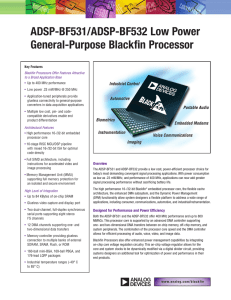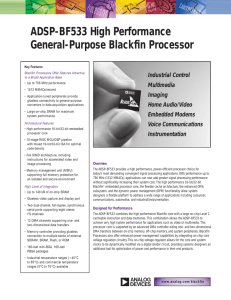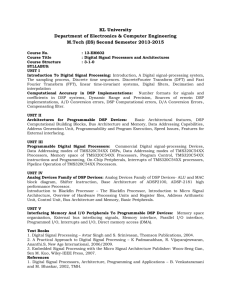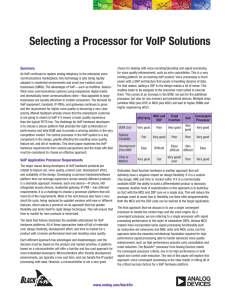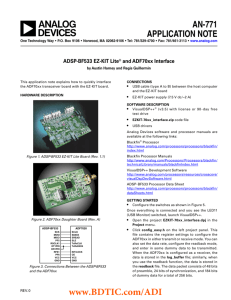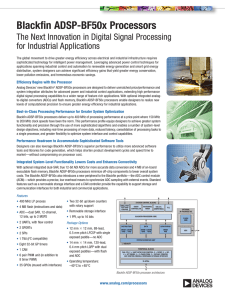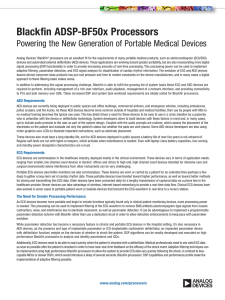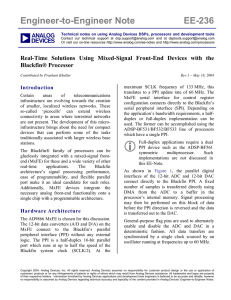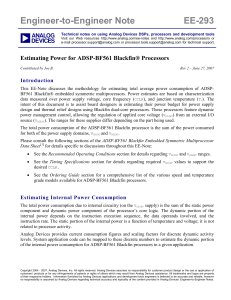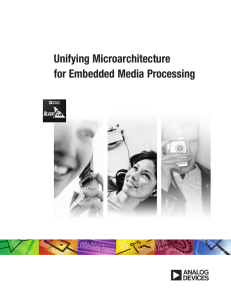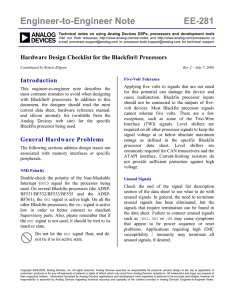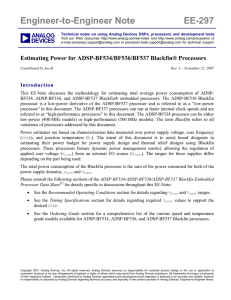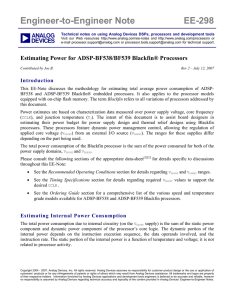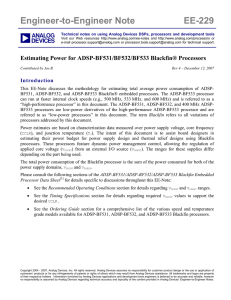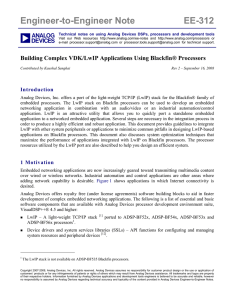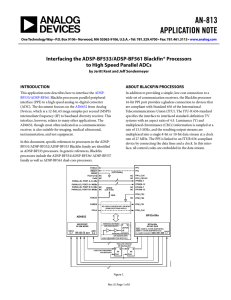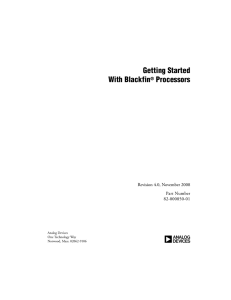Focusing on Video Surveillance Challenges with Blackfin Processors
advertisement
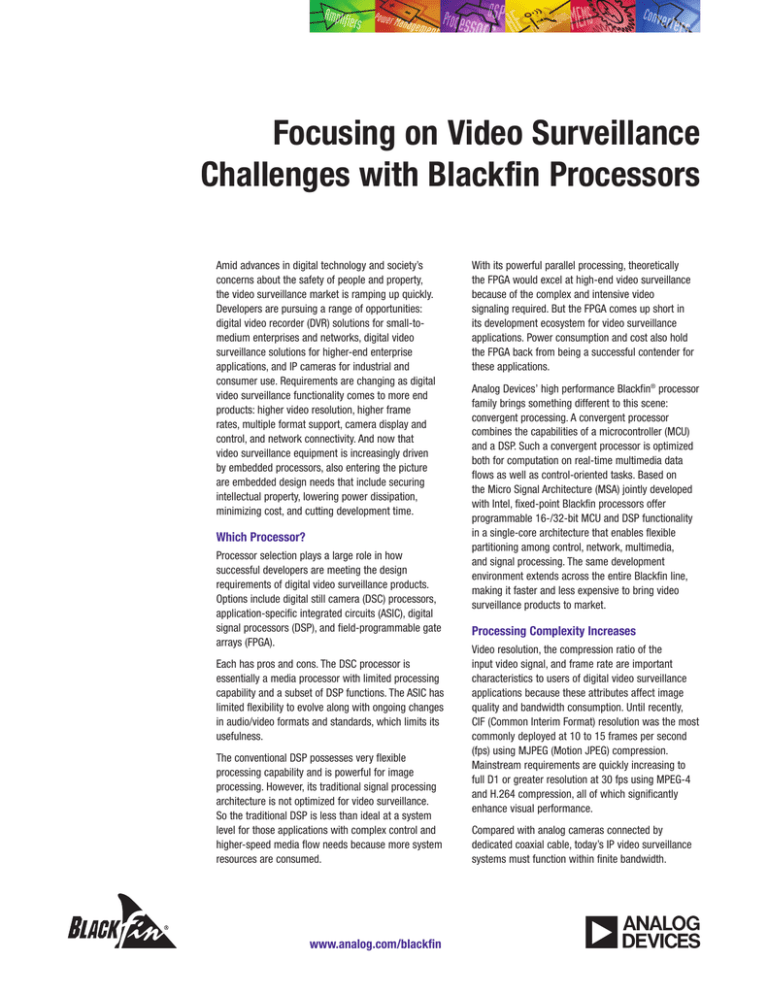
Focusing on Video Surveillance Challenges with Blackfin Processors Amid advances in digital technology and society’s concerns about the safety of people and property, the video surveillance market is ramping up quickly. Developers are pursuing a range of opportunities: digital video recorder (DVR) solutions for small-tomedium enterprises and networks, digital video surveillance solutions for higher-end enterprise applications, and IP cameras for industrial and consumer use. Requirements are changing as digital video surveillance functionality comes to more end products: higher video resolution, higher frame rates, multiple format support, camera display and control, and network connectivity. And now that video surveillance equipment is increasingly driven by embedded processors, also entering the picture are embedded design needs that include securing intellectual property, lowering power dissipation, minimizing cost, and cutting development time. Which Processor? Processor selection plays a large role in how successful developers are meeting the design requirements of digital video surveillance products. Options include digital still camera (DSC) processors, application-specific integrated circuits (ASIC), digital signal processors (DSP), and field-programmable gate arrays (FPGA). Each has pros and cons. The DSC processor is essentially a media processor with limited processing capability and a subset of DSP functions. The ASIC has limited flexibility to evolve along with ongoing changes in audio/video formats and standards, which limits its usefulness. The conventional DSP possesses very flexible processing capability and is powerful for image processing. However, its traditional signal processing architecture is not optimized for video surveillance. So the traditional DSP is less than ideal at a system level for those applications with complex control and higher-speed media flow needs because more system resources are consumed. www.analog.com/blackfin With its powerful parallel processing, theoretically the FPGA would excel at high-end video surveillance because of the complex and intensive video signaling required. But the FPGA comes up short in its development ecosystem for video surveillance applications. Power consumption and cost also hold the FPGA back from being a successful contender for these applications. Analog Devices’ high performance Blackfin® processor family brings something different to this scene: convergent processing. A convergent processor combines the capabilities of a microcontroller (MCU) and a DSP. Such a convergent processor is optimized both for computation on real-time multimedia data flows as well as control-oriented tasks. Based on the Micro Signal Architecture (MSA) jointly developed with Intel, fixed-point Blackfin processors offer programmable 16-/32-bit MCU and DSP functionality in a single-core architecture that enables flexible partitioning among control, network, multimedia, and signal processing. The same development environment extends across the entire Blackfin line, making it faster and less expensive to bring video surveillance products to market. Processing Complexity Increases Video resolution, the compression ratio of the input video signal, and frame rate are important characteristics to users of digital video surveillance applications because these attributes affect image quality and bandwidth consumption. Until recently, CIF (Common Interim Format) resolution was the most commonly deployed at 10 to 15 frames per second (fps) using MJPEG (Motion JPEG) compression. Mainstream requirements are quickly increasing to full D1 or greater resolution at 30 fps using MPEG-4 and H.264 compression, all of which significantly enhance visual performance. Compared with analog cameras connected by dedicated coaxial cable, today’s IP video surveillance systems must function within finite bandwidth. Using H.264 compression not only reduces the bandwidth needed by 33% compared with traditional codecs such as H.263 and MJPEG but also adopts a network-friendly architecture and syntax, in addition to providing a dedicated network extraction layer for efficient transmission of data packets. These methods employ sophisticated algorithms that introduce high computational complexity into the system. Beyond meeting these computational demands, flexibility is required of the core processor platform. Developers hope to do simple software upgrades as media formats and standards continue to evolve. They want to reuse their previous solutions—not redesign. It is also not always possible to forecast which formats and standards will be adopted or how quickly. Moreover, end products have to support multiple versions that come with their own networking dependencies. To reduce their risk and increase their products’ competitiveness, developers want their products to accommodate a range of codecs used in the network. The convergent MCU and DSP processing of the single-core Blackfin architecture offers core frequency performance as high as 600 MHz (1200 MMACs). With support for multiple channels of audio, VGA/D1 video applications, and MPEG-4, H.264, and Windows Media® formats, Blackfin processors handle advanced video encoding and decoding in high resolution. Because these capabilities are implemented in software, different media formats and functions are supported simply by changing high level software. Securing Intellectual Property Protecting intellectual property is important to developers, and that need becomes greater in a growing market such as video surveillance in which products are being designed with increasingly sophisticated features. Lockbox™ Secure Technology on Blackfin processors offers developers a means of enabling intellectual property protection through a privileged, or secure, mode of operation where only trusted code executes. Standards-based cryptographic algorithms can be employed to implement digital signature authentication, which lets the application establish trust and access the privileged mode of operation. To pass digital signature authentication, the application must be signed using a secret private key (known only to the signing party) and verified by the matching public key, which can reside on the processor itself. Only after it reaches privileged mode is the trusted application permitted access to protected memory and control access restrictions. The access restrictions serve to prohibit nontrusted applications from stealing, tampering with, or interfering in the operation of trusted applications in secure mode. ©2007 Analog Devices, Inc. All rights reserved. Blackfin and VisualDSP++ are registered trademarks and Lockbox is a trademark of Analog Devices, Inc. Trademarks and registered trademarks are the property of their respective owners. T07222-0-12/07 Power Dissipation and Form Factor The principle seems simple: When more processing capability is needed, operate the processor at a higher core frequency. The drawback is that power dissipation increases along with the core frequency. The increased power dissipation is a problem for surveillance products with a small form factor such as IP cameras and IP video intercoms. When higher power consumption raises the device’s temperature, the reliability of the circuit board, perhaps even the entire system, is affected. The Blackfin architecture excels at providing high performance at low power because of its dynamic power management capabilities. Blackfin processors can operate in five power modes—full on, active, sleep, deep sleep, and hibernate—each offering a different power/performance profile. In each mode, an internal regulator intelligently manages voltage to minimize power consumption and dissipation. Minimizing Cost, Streamlining Development Minimizing digital video surveillance system cost is not only about bill of materials (BoM) and development tools. It’s also about the larger landscape of total R&D costs that include software development, maintenance, upgrades, and any learning curve involved. For example, using a fixed-function ASIC appears to be a low cost answer when only the processor is considered. But the lack of flexibility is a weakness in an area where product requirements are continuing to advance. Developers have to change the ASIC chipset to support new media formats, codec improvements, and product upgrades. That adds major costs for ASIC simulation, validation, and prototyping. Then there is the long-lead nature of the ASIC development cycle, which can lead to a product missing its market opportunity. The convergent Blackfin processor speeds development by bringing together MCU and DSP functions in a single core. Development takes place using one unified set of software tools. Because programmability is a strong suit, changes and upgrades can be implemented quickly. An abundance of integrated peripherals saves time and cost that would otherwise be spent to build the peripheral circuit. Developers can also select the operating system that fits their experience and the profile of the end product. The development effort can focus on adding value without spending time on mastering the operating system. Blackfin processors support a range of choices: Micrium μC/OS-II, Express Logic’s ThreadX,® Analog Devices VisualDSP++® Kernel (VDK), μClinux,™ and Mentor Graphics’ Nucleus.® www.analog.com/blackfin Analog Devices, Inc. Worldwide Headquarters Analog Devices, Inc. One Technology Way P.O. Box 9106 Norwood, MA 02062-9106 U.S.A. Tel: 781.329.4700 (800.262.5643, U.S.A. only) Fax: 781.461.3113 Analog Devices, Inc. Europe Headquarters Analog Devices, Inc. Wilhelm-Wagenfeld-Str. 6 80807 Munich Germany Tel: 49.89.76903.0 Fax: 49.89.76903.157 Analog Devices, Inc. Japan Headquarters Analog Devices, KK New Pier Takeshiba South Tower Building 1-16-1 Kaigan, Minato-ku, Tokyo, 105-6891 Japan Tel: 813.5402.8200 Fax: 813.5402.1064 Analog Devices, Inc. Southeast Asia Headquarters Analog Devices 22/F One Corporate Avenue 222 Hu Bin Road Shanghai, 200021 China Tel: 86.21.5150.3000 Fax: 86.21.5150.3222
